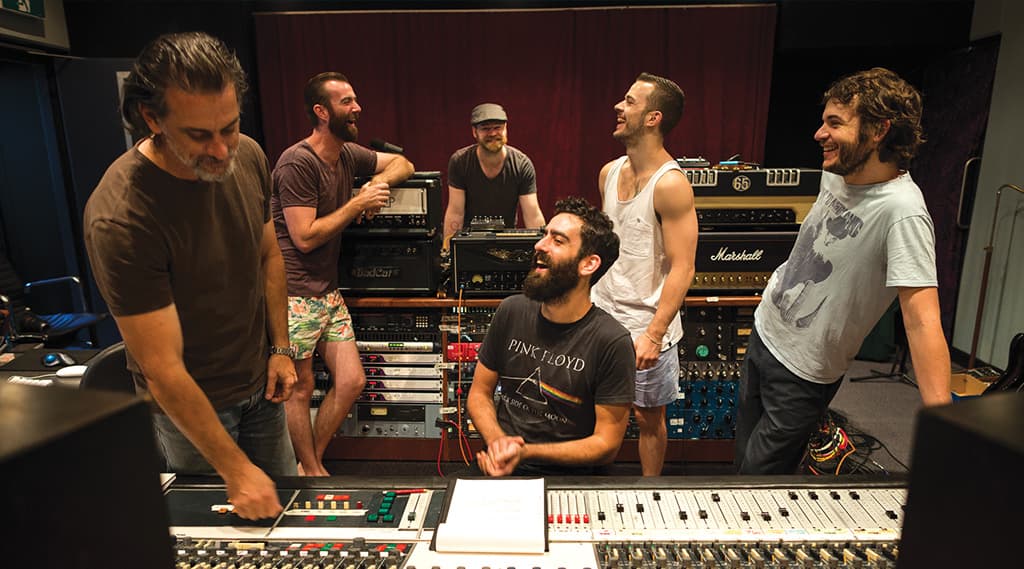
Timeless Beauty in Asymmetry
Karnivool and producer Nick DiDia embrace each other’s differences to stay off the beaten track on new album Asymmetry.
Guitar tabs are notorious for containing little more timing information than the odd bar break, but tabs for Western Australian prog rock band Karnivool’s tunes reach a new level of ambiguity: Strings of numbers, squiggles and slashes, with no time signatures, breaks, or points of reference in sight. One ‘helpful’ guitarist posted a string of riffs with just a couple of minute:second signposts along the way, while another blazed away a non-descript wiggle of numbers till there was a definitive 4/4 to latch on to, then promptly went wild again.
It’s a hallmark of the band: Their ability to switch in and out of complex, compound, even irrational time signatures without so much as breaking a sweat. But for guitarist Mark Hosking, it’s completely natural. So much so, he couldn’t even tell you what he’s playing in. “We just don’t think in time signatures,” said Hosking. “When we released We Are, there was quite a bit of internet talk around whether it was in 12/8, 6/8, 4/4, or if it changed halfway through, and were the verses different to the chorus? That blew me away when I heard that. I just don’t hear it like that, it seems very straight to me.
“Feel is way more important than what time signature it’s in. 4/4 is the most obvious, and easily grasped by humans, but it doesn’t always convey what you want to convey. If you’re doing something in 7’s, you feel it in 7’s for a while, and then it starts to feel normal. If you go back to 4/4 or something straighter, it feels jarring.”
Karnivool’s recent album Asymmetry celebrates this kind of left of centre beauty. And complex time signatures are just one the abnormal forces Karnivool rubs against common ideas to create something entirely new.
NAILING IT FIRST TIME
Asymmetry was recorded with producer/engineer Nick DiDia at Studio 301’s Byron Bay digs. But prior to arriving there, the band had wrangled together four or five songs in their Perth demo studio. It’s the first time the band has had their own place, a slice of factory space they’ve divvied up between a control room and medium-sized live room. Based around an iMac, ProTools, a couple of 002s, and some outboard preamps, it allows the band to lay down ideas in what amounts to a process of trial and error. “We have pre-production sessions where we pull songs together,” said Hosking. “Then turn them around on their heads, completely disintegrate them, scratch them up and find the best parts that we like.” Mining for gems can be a painful process, and Karnivool records are an ordeal, in the way that great records often are. “It’s a shitload of fun, but when you’re in the middle of it, it’s very challenging,” said Hosking. “We just don’t leave anything undone.”
Over in Byron, the band settled in for more pre-production with DiDia, building the songs up piece by piece. It can take a while for even the band to reach a consensus as to what makes a good Karnivool song because there’s no consistent structure. “I guess the only prototypical thing that always happens is someone has an idea,” said Hosking. “It could be an atmospheric sound, could be a bass line, could be a drum line. A lot of it stems from drum and bass lines that Steve and Jon [Stockman, bassist] have rapped out together and then either Drew [Goddard, guitarist] or myself add an idea to that.
“Once you’ve got those three elements — drums, bass and something else — that generally starts the evolution of a song and from that point on it builds quickly. Then you stop, look at it and go, ‘That’s terrible!’ And it starts at zero again. That may happen five or six times before you start to get something you like.”
Inevitably, the litmus test for a ‘good’ Karnivool song is consensus. Whatever makes the people involved in the project happy goes, even if it takes years to get there. Hosking: “Some of our songs have taken two years to like, some have come together in two or three months. Every song is different and every song has a different key motif or starting point.”
One of the benefits of setting up in pre-production mode at 301, was it allowed DiDia the freedom to nail down his sounds very early on. With Karnivool, the process revolves around inspiration, so being able to capture material as it was being formed allowed the band to hear what was and wasn’t working in a close proxy of how it would sound on the record. “We weren’t really keeping anything,” said DiDia. “But we had the ability to listen to everything in a much better atmosphere than your typical rehearsal hall.”
EVOLVING ARRANGEMENT
Karnivool’s rolling approach to arrangements was different to how DiDia usually likes to work. “Arrangement-wise, I try to have the songs way more together when we’re tracking it,” he said. “But it was a conscious decision by everybody to do it this way. There were some songs we worked out as we tracked them.”
The rule became: Record everything. If something good came out, DiDia would mark it and keep rolling. “The guys were really present too,” said DiDia. “After a take, they’d yell into the mics, ‘Hey can you mark that thing I did halfway through?’ It might have been something unexpected they would incorporate later into their main parts, or we’d just use the one we caught at that moment.”
A byproduct of piecing the songs together live was some atmospheric material, a lot of which ended up as neatly connecting ambience between Assymetry tracks in the grand prog tradition. DiDia calls them happy accidents. “In some cases,” he said. “Not everyone knew exactly what they were doing, so they’d be searching a little bit, and there would be noises and sounds happening while we were tracking the song.”
Once the beds were down, most of the guitars were overdubbed again, as the songs slowly started to bed down. Despite this free-flowing approach to arrangements, there wasn’t a lot of minute editing in post. DiDia just kept it to what he calls ‘tape edits’. “Because it’s the way we used to edit on tape,” he explained. “If you like a section, you copy it onto another bit of tape and use it twice. As opposed to getting in and moving snares and kicks around.”

4/4 is the most obvious, and easily grasped by humans, but it doesn’t always convey what you want to convey
DIFFERENCE MAKER
The means of getting to an arrangement wasn’t the only way DiDia and Karnivool differed. DiDia also likes to set project time limits for efficiency’s sake. “Some of the guys in the band would continue working and changing things whether they had five weeks or 50. It’s just in their nature to do that, whereas I’m not that way. I’m more, ‘hey, we’ve got this long to do it, let’s get it done!’ It’s not necessarily rushing — still taking time to experiment — it’s just being efficient and not wasting any time.”
The third difference was a more live approach. Not that Karnivool had specifically gone away from live sounds, but DiDia felt the new record could definitely lean more that way. DiDia: “I suggested the record be a little more live sounding, more of them in the room. I thought Sound Awake was really great, but after hearing them as a band, it wasn’t enough of ‘them’. It may have been one of the reasons they wanted to work with me because generally I track bands live and it carries that sort of vibe when it’s all done.”
The partnership between band and producer wasn’t entirely contrasting, but the force of a few opposing ideals certainly helped shape Asymmetry, capturing the spirit of the album in its process; that two differing ideas rubbing against each other can produce something better than sticking to the middle.
BARE BONES
The layers of a Karnivool record, and really, any prog rock record, would seem to suggest there’s excess to be found in every corner of the recording process. But in reality, DiDia started out with a bare bones version of his normal recording setup. “Maybe five mics on the drums, which are an old AKG D30 on the kick, Neumann KM184s on the overheads, a Shure SM57 on the snare,” said DiDia. “I start there and add tom mics and things as we go. The guitars are always SM57s and Neumann KM86s on the cabinets. All pretty normal. I tend to find that those things tend to capture what’s going on in the room really well so it doesn’t always sound the same. It depends on the sound that’s coming out of the room. And that depends on the players and what they’re playing more than anything else, especially drums.
“I try to end up with the drums sounding like a single instrument, rather than a collection of 10 or 12 different things he’s hitting. And that usually starts with the overheads — sometimes it’s the room mics — to try to capture the instrument as a single piece. You add other mics as you need, just to make sure things are loud enough in the balance.
“Like most great drummers, Steve was really good at balancing himself. You use that to your advantage and add little things here and there, sometimes you need to turn up individual instruments within the drum kit to make them present enough. But in general, if you just listen to the drum tracks by themselves, it sounds like a drummer in a room. That’s generally what I try to go for.”


EDGE OF AGGRESSION
DiDia has done a lot of records in his time, but his engineering of hard rock records by Rage Against The Machine, Stone Temple Pilots and Pearl Jam demonstrate an uncanny ability to capture a band’s aggressive edge.
“It’s the way I was taught to make those kind of records,” said DiDia. “The drums are a good example. If you listen to the drum tracks by themselves after the mix, they sound really over the top and roomy. I was taught a lot of that room was going to get sucked up and that distortion is going to be calmed down by anything that’s thrown on top of it.
“So there are two things. One, you try to make your arrangements as sparse as you can in order to make those elements stick out. But at the same time you have to overcompensate. I learned on tape. And a lot of the time you didn’t have the luxury of unlimited tracks so you had to bounce things together knowing they’d be used that way in the mix. It was important to always over-emphasise any reverb or aggressive tones, because when other things get piled on top in the mix stage it all inevitably gets toned down. If you have tones you think are good but aren’t over-hyped or aggressive, when you get to the end stage it all sounds a little dull and not as exciting as you want it to be.”
AudioTechnology: And have you hit on key sounds or pieces of gear that give you that tone in the first place?
Nick DiDia: I’ve discovered that I’ve become a bit of a pedal snob. I have a bunch of amps and guitars, but they always have their own pedals. We’ll get a sound through a pedal board and listen to it, then bypass the pedals entirely and plug it into the amp and nine times out of 10, the amp sound without the pedals has a lot more depth to it. It sounds more present, deeper and warmer sounding — more like you’re standing in front of an amplifier.
Most guitarists hear that difference, so then it becomes a matter of figuring out what pedals you need for the sound you’re trying to get. And if you can get it without the pedals you do that.
With Karnivool, we experimented using pedals either in different orders or different places in the amp, because some of the newer amps have effects loops in the back of them as opposed to just putting it before the preamp. But generally, the less pedals the better. Even if it’s a ‘true bypass’ pedal, it’s not the same as plugging right into the amp.
AudioTechnology: Do you re-amp and double those guitars?
Nick DiDia: I’m more into getting it right when you track it, and recording all delays and reverbs. We have this old AKG BX20 spring reverb up in the ceiling of 301 that really sounds great on guitars and sometimes we would just print that along with the guitars. I generally use it on the microphone side before it went to tape or ProTools. I remember reading an interview with Brian Wilson where he said they would always print the reverbs because there was something different about how the microphone hit the reverb as opposed to coming back off tape.
The reason we used to do it that way was because we didn’t have enough tracks. Now that we have so many tracks available it’s really easy to do and you can sort it out later if you need to.
JUST PRINT IT
AudioTechnology: How far do you take the ‘just print it’ philosophy?
Nick DiDia: Generally, if I have two mics on a guitar cabinet or even two amps running one sound, unless it’s a specific stereo sound I’ll always print the combination on one track, not the separate microphones.
But a lot of the sounds ended up stereo. We would use one track for whatever microphones were on the cabinet, so if there was an SM57 and a KM86 on a cabinet, they would go to one track. And the track on the other side would be the room mic. If you’re standing in the room and you hear the sounds bouncing off the walls, that gets lost on the close mics. But there is a certain sound you get from the room that people are used to, because that’s the way a lot of microphones have been used on guitar amps over the years. I like the idea of having a separate room mic that you can move around in the stereo field to make the guitars seem like they have more depth.
AudioTechnology: In the same way as the drums, are you using a lot of that room sound?
Nick DiDia: I try to record everything the way the console is set up in Byron: it’s an old Neve that has a 24-track monitor section, which would have been your returns in the old days. I try to leave those at zero and print all my levels so I don’t have to move those. That way, when it comes to mixing time, you set everything at zero and it should sound like the record with a just a few little adjustments here and there.
So a lot of times I’ll just print the room mics really low, because I know I only want a little bit, and print them in the stereo field where I want them to be.
AudioTechnology: And does this train of thought carry over into how you record the other instruments?
Nick DiDia: John had a couple of different cabinets we went through. And I have an old Fearn VT3 DI. It’s a big tube DI that just works really well with bass. So we would record a clean DI before all his effects; and then his amplifier, which would be effected; and then a separate amp that would have amp distortion. He could either use it throughout the entire song or turn it on and off in certain parts with a line switcher.
We mainly used a Neumann U47 and he would just sing out in the room. Ian [Kenny] is such a great singer. When we were tracking he’d sing into a Shure SM7 in the control room, because it was easier to get isolation. We used some of those vocals, but he didn’t necessarily have all the finished lyrics when we were tracking, so he’d have to re-sing them. But had the lyrics been together, we could have easily used his tracking stuff. Just one of those guys.
It was important to always over-emphasise any reverb or aggressive tones, because when other things get piled on top in the mix stage it all inevitably gets toned down

CHASING THE VIBE
AudioTechnology: Do you use many effects to exaggerate the live vibe?
Nick DiDia: Other than the AKG spring reverb, I also used an EMT plate, and a Lexicon PCM60, which is a really simple reverb Lexicon made prior to the PCM70, which is more of an overall effects unit that has delays and all kinds of stuff in it. The 60 is really simple, it has plate and room in a couple of sizes and I used that pretty exclusively on the drums, but occasionally on vocals too.
For delay we have an old Ampex machine we use as slap and tape delay. I also have a Watkins Copycat which is basically an Echoplex with four or five tape heads and different selectors on it. For longer delays I used the UAD plug-ins version of the Lexicon 224. And then I have a bunch of old crappy digital delays I’ll use occasionally.
AudioTechnology: How big a part does compression play in drawing out the vibe?
Nick DiDia: I’ll compress a little going in to tape, usually just a pair of Universal Audio 1176s on the rooms, Teletronix LA3As on overheads and I’ll use an Empirical Labs Fatso on the stereo sub where I send all the drums and parallel compress them. There’s compression on vocals going in and a little bit coming out. And then I have a two-mix compressor from an SSL. It’s not compressed as much as we used to do it, but there’s some in there. I try to record most of it to tape so it sounds the way I want it to sound without having a bunch of outboard running all the time.
AudioTechnology: Is it only out of necessity that you compress on the way in?
Nick DiDia: It used to be out of necessity as you only had a certain number of compressors so you had to do it on the way in. But when you print it as you go, it informs all your other decisions about how everything else is supposed to sound.
The benefit is two-fold really. For one, the band hear what they have down, and the other reason is, it’s hard for me to know what the drums are supposed to sound like if I don’t know what the bass and guitars are sounding like. So I don’t really record in a vacuum, recording the drums by themselves and then figuring out what the guitars and bass are supposed to sound like over that.
Which is why I guess it sounds like a band when it’s done. Because the idea is, it sounds like a band when we start.
SIGNATURE MIX
AudioTechnology: Do you have to mix any differently given there’s often not a typical verse/chorus/bridge structure?
Nick DiDia: It’s just a case of doing several passes as an entire song and then going back and zeroing in on certain sections. I was taught that those initial mixes — like the first time a band plays a song — can have spontaneous things you may not do if you think about it too much.
Sometimes there’s a roughness to them that suits the song and the style. So we captured all of the rough mixes, and instead of trying to copy them, I would sometimes actually use the instrumental monitor mixes, or parts of them, or it might be half and half, or even just using it as a guide. It was different song to song.
AudioTechnology: With them jumping in and out of different time signatures, is it important for you to know exactly what meter they’re playing in?
Nick DiDia: I grew up with Yes, Genesis, Pink Floyd and King Crimson. It seems very natural to me. It’s funny, I’ve been reading some of the comments about We Are, and everyone is talking about the time signature and discussing where the ‘one’ is. And I don’t have any problem bopping my head to that song.
It’s a tribute to Steve, but also to how the band writes, that it’s easy to listen to without thinking about time signatures. That’s one of the things the great prog drummers had; Bill Bruford, Phil Collins, Allan White, they could play something intricate and difficult, but it would have a groove to it.
I remember reading Bill Bruford say he didn’t think of anything in time signatures, he’d just follow the song and the lyric. It’s that way with Steve. I’m sure he knows, because if something came up he’d instantly say, ‘No, that’s a bar of 15 and then it goes back to 7,” but when he’s playing he’s just playing.
He played to a click, just not a time signature-dependent one. But occasionally we would need the meter to set delays and things like that. Most of the time I could figure it out, but sometimes I just had no clue and would have to ask, ‘That’s a what? Count that for us.’



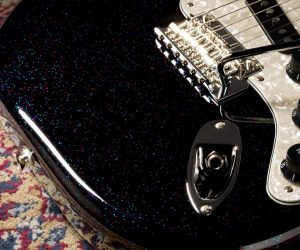
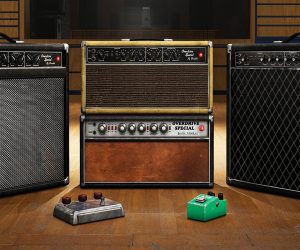




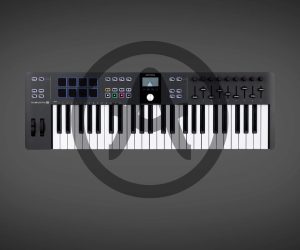

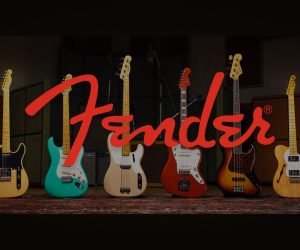

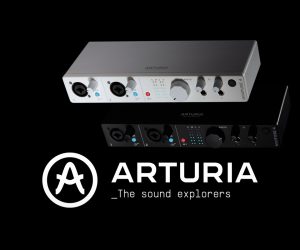


RESPONSES